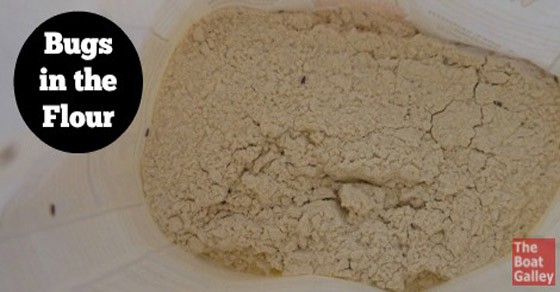You do not want to see this when you open up a bag of flour. Little black dots, crawling everywhere. But they’re there, so what do you do?
No matter what precautions you take and no matter how carefully you store your flour, chances are good that it will happen some day. This bag had been stored inside a Ziploc with a few bay leaves in it. But somehow the Ziploc didn’t get completely sealed the last time I used it and the bugs discovered a new home.
Step 1 is to get the buggy stuff off the boat. Not just into a trash bag, but actually off the boat. Pitch it. While old-time sailors would eat wormy flour, calling it an extra source of protein, leaving it on the boat will just cause the bug problem to spread. Yes, I know that some people will say you can salvage the flour by sifting it to remove the bugs. That doesn’t remove the eggs and you’ll be fighting a losing battle as the next generation arrives. Get rid of it if you want to end the problem.
Step 2 is to go through all the other containers in the same locker and adjacent lockers. Check everything and see if it has bugs too. Be sure to check any baking mix (“Bisquick”), box mixes and other packages. Anything with bugs has to be pitched (I know, it hurts).
If the buggy food was in a good plastic storage container, you can pour out the flour or mix and then immediately wash out the plastic container with a bleach solution. If it was in a Ziploc, throw the whole thing out — don’t try to reuse the bag.
Step 3 is to take every single thing out of the affected lockers and wash the outside of each with a bleach solution before setting it down elsewhere. If you don’t disinfect the outside before putting the containers somewhere else, you can transfer eggs and perpetuate the problem.
Step 4 is to carefully wipe out all the affected lockers with bleach solution. Get every single surface. If you can’t use bleach because of fabric nearby, use either ammonia or vinegar — don’t mix them — and the stronger the solution, the better.
Step 5 is to dry out the lockers and the containers. Add a few more bay leaves to each “non-buggy” container as an added precaution, and toss a few bay leaves into each locker.
Step 6 is finally to put everything away.
And — perhaps most importantly — keep a sharp eye out over the next several weeks for any lingering bugs. If you see any, take immediate action so as to avoid an even larger infestation.
While bugs are more likely in flour purchased from barrels and in small villages, they can be found almost anywhere. Don’t ignore it if you see even just one . . . where there’s one, more are certainly nearby!

Carolyn Shearlock has lived aboard full-time for 17 years, splitting her time between a Tayana 37 monohull and a Gemini 105 catamaran. She’s cruised over 14,000 miles, from Pacific Mexico and Central America to Florida and the Bahamas, gaining firsthand experience with the joys and challenges of life on the water.
Through The Boat Galley, Carolyn has helped thousands of people explore, prepare for, and enjoy life afloat. She shares her expertise as an instructor at Cruisers University, in leading boating publications, and through her bestselling book, The Boat Galley Cookbook. She is passionate about helping others embark on their liveaboard journey—making life on the water simpler, safer, and more enjoyable.
Simplify meal prep on board with proven strategies for provisioning, maximizing fridge space, and cooking delicious meals aboard your boat.










Paul Schroder says
Carolyn
I just received my copy of your new book and I can tell right away that it is going to be one of those well worn and tattered books that inhabit my kitchen/galley.
Nicely done!
Ann says
We battled this at home for a time and a few additional things:
Do not use most plastic or Tupperware containers. I found bugs in my Tupperware cereal keepers and my flour container!! I ended up putting my flour and rice into containers from King Arthur Flour and they have been bug-free for about 10 years now. Ziplock baggies are useless unless you are storing in the fridge. They can eat right through the plastic.
Freeze any grains for 3-5 days if you can. Forget the 24 hour thing – it’s not enough time to kill the eggs. You need at least 3 days and in a boat freezer that doesn’t get as cold as a land freezer, I’d go longer and keep it low.
You can also purchase Pantry Pest traps that will catch the moths that come from these bugs. I would only have one on most boats since having more than one in a smallish area can compete and the moths will ignore it. At my home, I kept three in different rooms (one in my pantry in the kitchen, one in the pantry in the laundry room and one in our den next to our rabbit) and it worked great.
Lastly, I’d keep some bay leaves right in the lockers where you store the food, not just in the food. It will help drive them away. I’d also regularly clean the lockers just to be proactive. 🙂
Carolyn Shearlock says
My only comment is that I think you can use any good locking plastic containers, such as Lock & Locks or Sterilite that just can’t pop open. Containers that don’t have a positive lock on them can open and then the bugs get in.
Barbara Lowell says
Living in FL bugs are my constant companions. Please do not throw overboard any plastic bags. It sounds like you suggested this tho you didn’t say overboard, but where is “out” on a boat. A huge whale beached recently and his intestines were filled with throwaway plastic bags and some agency, I think the EPA says this is very common. Very sad.
Carolyn Shearlock says
No, no, no. You’d never put plastic bags overboard, since that’s about the worst thing anyone can do!! When I said to get the item off the boat, I meant in the nearest trash receptacle.
Pit de Jonge says
Why do’nt we use vinegar any more to clean the lockers? Its also cheap, neutralises salt, but it’s less agressive for paint or vanish etc. It was used by the navy for centuries. It seems to be as effective as bleach. Exept: your boat will smell more like a beaker of gherkins instead of a swimming pool. Does anyone has any experience with vinegar?
Carolyn Shearlock says
I use vinegar a lot for cleaning. However, bleach is a more effective disinfectant in most cases. And when you have bugs, it’s important to disinfect where they’ve been as they can track germs and excrement.
Bruce Comeau says
I read an blog from wondering dolphin about freezing flour first for around 24 hours. I’m not sure the exact post but you could contact them on facebook or there blog. http://www.wanderingdolphin.blogspot.com/
Hazel Peterson says
Good adviceat home too. We have had flour from the store that was infested.
Mark Hancheroff says
There, I have you! You’re completely dished! Do you not know that in the service…one must always choose the lesser of two weevils.
Carol Dean says
When I purchase flour I always bring it home and put the whole bag in the freezer overnight. It apparently kills the eggs, this has worked for me for years.
Dianne Bowers Turner says
Several years ago I had these bugs get in my pantry. Someone told me to put Wrigleys gum on the shelves and leave it there. I did and the bugs went away and I’ve never had them again.
El says
something like 10 sec in the microwave should kill the beasts as well. We “import” them here a lot (malta) with pasta. And BTW any smell anywhere? Vinegar!
Sami Bolton says
We have had really good luck with those gypsy moth traps. They use pheromones.
Judith Nelson Cruzan says
I sometimes buy flour when it’s on sale. I dry can it in mason jars. It keeps for a really long time.
Hannah Gardner says
Wipe down shelves with tea tree oil, keeps on working after bleach or vinegarhas evaporated.
Randy Sysol says
Nancy Garcia Sysol
Jim Fayhe says
Muratic acid (weak hydrochloride acid) is a better disinfectant and bug killer than vinegar. And it may sound yucky, but toilet bowl cleaners works well to disinfect be cause it is usually hydrochloride acid-based. Make sure you use gloves. (Sadly, I’m a chemical engineer.)
Carolyn Shearlock says
Be careful, though, as both can stain counters!
Tee says
The one time I got pantry moths was because I had bought products at one of those mark down discount stores. I’ve learned never to buy any food item from big lots Christmas tree shops or in a store that doesn’t normally have a big grocery turnover
Tee says
Along the same lines, when I was a charter yacht chef in the Caribbean, I never brought boxes from the grocery store onto the boat because I quickly learned that roaches live inside those boxes feeding off the glue. We brought boxes as far as the dinghy but they never came onto the big boat .
And always wipe your sinks down and dry it well before you go to bed each night because bugs love to feed and drink in the sink
Linda Spell says
We cruised for three years in the tropics on our sailboat and currently live and boat on our trawler in Florida, heading for the Caribbean soon. We always have used glass canning jars of all sizes for flour, rice, grains, pasta, cereal, etc., and always have placed a large dried bay leaf in each jar. The bay leaves do not affect flavor – they just do not allow weevils to develop. We NEVER EVER have had a problem with weevils – even with flour and such we have bought in suspect countries. I do not recommend softer plastic like Tupperware. Weevils actually can bore into softer plastic containers – and then can bore out of them to enter others. Canning jars are so sturdy, they are virtually indestructible, and you can tape a contents label to them top or side. We did switch to the hard plastic canning jar lids when we were getting corrosion on the two-part metal lids but the plastic is so thick the weevils cannot get through. We use the canning jars on the boat and in our home. In the pantry it is nice to be able to see when you need to replenish the supply. Thank you for your helpful site.
cyndy says
Hi Carolyn,
I’ve lived on board since 2012. For pasta, rice, flour, sugar, etc.
The products are removed from all packaging and placed in stainless canisters. The canisters are laid on the deck in the hot Florida sun for a day or 2 or 3, depending on how busy I am 😉
Never a bug.
Well I did get bugs one time, finally traced them back to a bracelet I bought in Grenada. Now natural jewelry, like bracelets, have a can they go into for a few days. Kills the bugs, the larvae and the eggs.
In the beginning, I had bugs grow in the Freezer in a lovely cake of cheese. No idea what to do about that.
Also, since there are no pets or children on the boat I made Twenty Team Borax bisquits that I toss back into places I cannot reach such as under the bed, behind the stove, backs of lockers. It is very poisonous to pets and babies. I mix in just enough sweetened condensed milk to make a VERY thick goo. Form into bisquits, dry in oven or out on that hot deck (use waxed paper or parchment – not your only cookie sheet. Made them in 2014 and they’re still working. I get an occasional fruit fly but they don’t last long.
Fair winds!!
c
Florian Wolf says
Well, well, well – we have the ‘bug problem’ every rainy season and a few months after that in our tropical : tiny ants ! They come out of nowhere once they smell (?) some splattered food on the kitchen benches, march in a fairly organized manner towards their target & munch it up. While initially we were thinking “Arggh, how yucky !” we learned to respect these little critters, as they tidy up behind us meticulously, and once finished they disappear again into nowhere -we have no idea where they live, tried to poison them a few times, but then gave up and succumbed to a peaceful coexistence.
A completely different story is them suddenly being in our flour, sugar etc.; initially we sieved like mad hatters, but became more lenient and now view them as adding some crunch to whatever we prepare. Most of us love crustaceans, so why not insects ? I had deep-fried silkworms (“caterpillars”) in hot chilli sauce once in a Bangkok street restaurant, and they tasted great – slightly mushy consistency of the interior, great crunch of the shell & a lovely nutty flavor. Have to try deep-fried locusts though, as we have the occasional infestation in the garden – they are 10 cm long, fat & greyish green, supposedly good roasted in honey with sesame seeds….
Christian Lenz says
Is there any truth to the idea of putting flower and any wheat based products in the freezer for 24hrs immediately after buying it to destroy any eggs? We have heard this from a number of cruisers.
The Boat Galley says
I’ve heard that many people do it, but I’ve never had the freezer room to try it. I think it probably does work or I wouldn’t hear it from so many.
jim f says
The “freezing flour” thing works, and doesn’t work. Freezing flour will kill hatched critters. It will not kill the eggs of unhatched critters.
Melody-Charlie Cook says
Growing up, my mother used to freeze a new bag of flour for a week or more. I continued this practice as an adult and on land at least I never had bugs in my flour. Being new to boat life i have no anecdotal evidence to provide. Lacking the available freezer space, I doubt I ever will. Good luck!
Joel Turner says
https://youtu.be/e4PzpxOj5Cc
Lawrence Gleason says
Cook ’em.
JohnT says
Although quite some time since first published, there is no need to throw any flour, pasta or rice out if treated properly to start with. When doing your shop, contact the local ice cream supplier and buy a small block of “dry ice”. Put a chunk in the box containing every plastic pack of weevil loving pasta, flour or rice – let it start “smoking” over the lip of the container and seal. No weaviles (or any other bugs) can survive or breed in a carbon dioxide environment devoid of oxygen.